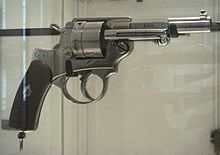- Henri-Gustave Delvigne
-
Henri-Gustave Delvigne (Hamburg 1800–Toulon 1876) was a French soldier and inventor. He became a captain in the French infantry service, from which he resigned on the outbreak of the 1830 July Revolution. Delvigne revolutionized rifle technology and rendered it proper as a weapon.
Contents
Chambered magazines
In 1826 Delvigne invented a new method which greatly simplified the use of rifled guns, and created a rifle known by his name. In this rifle the chamber was smaller than the bore, with which it was connected by a spherical surface equal in radius to the ball used. The powder was poured from the muzzle into the chamber, upon which the ball rested when dropped into the bore. When forced against the chamber rim by ramming (with three strokes of a heavy ram), the bullet would become deformed and flatten, so as to expand in diameter against the inside of the bore, allowing the bullet to press against the rifling grooves. When fired, the bullet would accompany the rifling and spin.[1]
Wooden sabots
In an evolution to this first method, Delvigne introduced a wooden sabot at the bottom of the bullet, which would limit the improper deformation of the lead bullet, but still allowing for its radial expansion to fit the rifling grooves.[2]
According to the artillery historian John Gibbon:
"Delvigne, by placing a chamber at the bottom of the bore of an ordinary rifle, and making use of it to force the ball, dropped loosely into the bore, did away with the great objection to the use of rifles in war, the difficulty of loading them, and gave an impetus in regard to investigations about the arm, which has created a perfect revolution in the system of arming infantry, by leading to the present efficient weapon. This event led to the adoption, in 1842, in the French Army, of the chambered carbine and rampart rifle-musket firing spherical ball"
— John Gibbon, The Artillerist's Manual 1860.[3]
In all these cases the radial deformation of the ball against the rifling grooves would permit a more efficient spinning of the ball. As a drawback, the very deformation rendered the bullet aerodynamically less efficient.
Cylindro-conical bullets
From 1830, Delvigne started to develop cylindro-conical bullets.[4] The stability of the bullet would be further improved by the introduction of the Tamisier ball groovings. However the introduction of ball groovings hampered the expansion of the bullet against the rifling grooves.[5]
Delvigne's invention was further improved by the French officer Thouvenin, who induced the deformation of the bullet by placing a stem inside and at the center of the powder chamber. When hit by the ram, the bullet would expand radially against the rifling grooves and at the same time wrap around the stem, giving it a more efficient and aerodynamic shape.[6]
These inventions mark important steps in the improvement of the rifle, and are precursors to the Minié ball, the development of which Delvigne also contributed to.
Delvigne also devised some life-saving apparatus, particularly life rockets. His publications include Exposé d'un nouveau système d'armement pour l'infanterie (1836).
The Chamelot-Delvigne was a revolver pistol he developed with the Belgian gunsmith J. Chamelot, and which was adopted by the French Army in 1873.
Works
- Exposé d'un nouveau système d'armement pour l'infanterie (1836).
References
- ^ The Artillerist's Manual by John Gibbon p.125 [1]
- ^ The Artillerist's Manual by John Gibbon p.125 [2]
- ^ John Gibbon, The Artillerist's Manual 1860, p.135 [3]
- ^ "Delvigne began experimenting with elongated bullets as early as 1830. He designed a cylindro-conical bullet with a hollow base that would expand to fit the bore" in Britannica Online Encyclopedia [www.britannica.com/EBchecked/topic/156901/Henri-Gustave-Delvigne]
- ^ U.S. Regulars Civil War Archives
- ^ John Gibbon, The Artillerist's Manual 1860, p.135 [4]
- This article incorporates text from an edition of the New International Encyclopedia that is in the public domain.
Preceded by
Musket Model 1777French Army rifle
1826-1846Succeeded by
Carabine à tigeSmall arms Charleville musket · Delvigne rifle (1826) · Thouvenin Carabine à tige (1846) · Lefaucheux M1858 revolver · Minié rifle (1849) · Tabatière rifle (1864) · Chassepot rifle (1866) · Gras rifle (1874) · Lebel rifle (1886) · Modèle 1892 revolver





Machine guns Cannons Year XI system (1803) · Paixhans gun (1823) · Valée system (1828) · Canon obusier de 12 (1853) · La Hitte system (1858) · de Reffye system (1870) · Lahitolle 95 mm (1873) · de Bange system (1875) · Canet 320 mm (1880) · Canon de 75 (1897)
Warships Ammunition Lepage fulminate (1807-10) · Pauly-Prélat integrated cartridge (1808) · Prélat percusion cap (1818) · Lefaucheux cartridge (1836) · Tamisier ball (1841) · Minié ball (1847) · 8 mm Lebel smokeless powder cartridge (1886)
Systems Lepage percussion system (1807) · Marié-Davy naval periscope (1854) · De Bange breech obturator (1872) · Du Temple high-circulation steam engine (1876) · Krebs naval electric gyrocompass (1880) · Smokeless powder Poudre B (1886)
Operational
usageNapoleonic Wars · French conquest of Algeria · Crimean War · French weapons in the American Civil War · Franco-Prussian war
Categories:- 1800 births
- 1876 deaths
- French didactic writers
- French inventors
Wikimedia Foundation. 2010.



